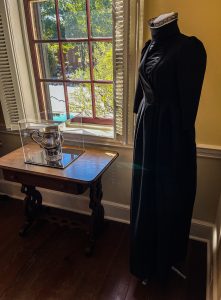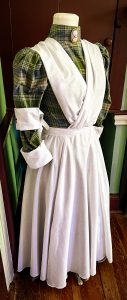
The Gorgas House Museum, and museums in general, provide spaces for people from multiple disciplines, interests, and backgrounds to come together. This includes our off-campus community members as well as University of Alabama students, faculty, and staff. Often though, our partnerships include other museums and organizations. We were happy to partner with Tuscaloosa’s Mildred Westervelt Warner Transportation Museum (MWWTM), UA’s Department of Theatre and Dance, and the Missouri Historical Society, to showcase dress recreations from the early 20th century.
The Gorgas House Museum is currently showcasing two dresses created by UA students while the larger and full exhibition, Threaded Through History, is at the MWWTM. UA student Marie Bonds created a black mourning dress. It contains a fake blouse insert and dresses of this type were worn during a period of mourning for a deceased loved one. Different stages of mourning required different types of black garments.

During a time of deep mourning, women wore black dresses, trimmed with black crêpe or fragment with a crimped appearance, and long black crêpe veils. In a second mourning period, crêpe fabric was removed, and only black clothes were worn. A final period of mourning, called half-mourning, included black clothes, but also shades of white, blue, and grey.
UA Student Joseph Musgrove designed a nurse’s uniform. Joseph said this about the dress, “I modeled the nurse after the Red Cross nurses in research photos from the 1890s. The women who were acting as nurses during war efforts (Spanish-American War) were largely volunteer or untrained, and they would wear a simple day dress underneath a ‘uniform’ of [a] full apron, and an armband bearing the Red Cross or a traditional nurse’s cap. I named my dress Lily to represent good health, peace, and the delicate state of mourning.”
Please visit the MWWTM for the full and free exhibition!
– Written by Brandon Thompson, Director of the Gorgas House Museum